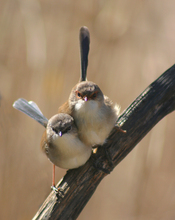The Evolution of Social Behavior: Cooperation and Conflict
 In the course of a day, animals cooperate in a myriad different ways in order to increase their, and their species, chances of survival. In many species, for example, raising offspring requires help and cooperation from multiple individuals, and fending off predators can often be more effective when animals cooperate together as a herd.
In the course of a day, animals cooperate in a myriad different ways in order to increase their, and their species, chances of survival. In many species, for example, raising offspring requires help and cooperation from multiple individuals, and fending off predators can often be more effective when animals cooperate together as a herd.
But cooperation also comes at a cost. An individual animal, for example, might benefit from increased survival if others did more of the work.
How do animals cooperate successfully in the face of the tension between their common or group interests and their conflicting private or individual interests?
That is one question postdoctoral fellow Erol Akçay is pursuing as a part of his research at the National Institute for Mathematical and Biological Synthesis. Akçay, who has a Ph.D. in biology from Stanford University, is a theoretical biologist who uses evolutionary game theory to model the dynamics of cooperation and conflict in animal social behavior.
"My strategy is to develop simple models to understand how the tension between common and private interests can be resolved," says Akçay, who offers as an example the behavior of a pair of birds. "Imagine that the male and the female bird both have three options available to them: to forage and bring food to the offspring, to stay near the nest and defend it, and to forage for themselves and increase their own chance of survival."
"The birds need to allocate their time between these three activities. The question then becomes: how do parents make the allocation decisions in such a case? How they allocate their time affects how successful the brood is."
In modeling the problem mathematically, Akçay considers two types of behavioral mechanisms responsible for choosing how pairs of animals might allocate their time to different tasks cooperatively: internal motivation and learning.
Being internally motivated to cooperate evolves when the payoffs are clear and in situations where individuals are interacting socially, Akçay says. However, in more uncertain situations, animals have to learn how to cooperate. Akçay's goal is to develop a mathematical model for showing how motivations are learned, or in other words, how individuals become motivated to cooperate.
Akçay also studies cooperation and conflict in mutualisms between species. A mutualism is a biological interaction between two organisms where each individual derives some kind of benefit, like increased survivorship. The Rhizobia-legume interaction is a classic example of a mutualism, whereby the soil bacteria Rhizobia supply amino acids to the plant and in return receive organic acids as a carbon and energy source. Using elements of bargaining theory and cooperative game theory, Akçay tries to generate a theory of when mutualists can co-exist and when they cannot.
Originally from Istanbul, Turkey, Akçay initially set out to become a theoretical physicist, but was always drawn toward biology and ecology and evolutionary questions, and now more specifically, he hopes his research will contribute to a greater understanding of how evolutionary dynamics affect social interactions.
"In the broadest sense, we will gain a fuller understanding of how natural selection has led to the diversity of interactions we see around us," Akçay says. "More specifically, my work on social evolution will hopefully lead to a theory of how animal groups function and evolve."
For more information about postdoctoral fellowships and other research and educational opportunities at NIMBioS, visit our website at http://www.nimbios.org.
#
NIMBioS
1122 Volunteer Blvd., Suite 106
University of Tennessee
Knoxville,
TN 37996-3410
PH: (865) 974-9334
FAX: (865) 974-9461
Contact NIMBioS


